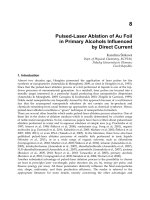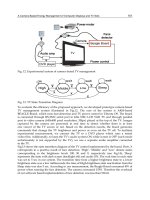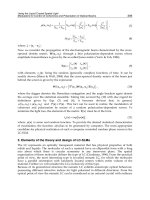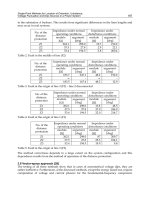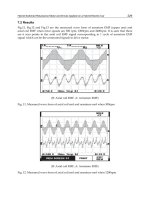Chapter 012. Pain: Pathophysiology and Management (Part 9) docx
Bạn đang xem bản rút gọn của tài liệu. Xem và tải ngay bản đầy đủ của tài liệu tại đây (13.06 KB, 5 trang )
Chapter 012. Pain:
Pathophysiology and Management
(Part 9)
Treatment of Neuropathic Pain
It is important to individualize treatment for patients with neuropathic pain.
Several general principles should guide therapy: the first is to move quickly to
provide relief; a second is to minimize drug side effects. For example, in patients
with postherpetic neuralgia and significant cutaneous hypersensitivity, topical
lidocaine (Lidoderm patches) can provide immediate relief without side effects.
Anticonvulsants (gabapentin or pregabalin, see above) or antidepressants can be
used as first-line drugs for patients with neuropathic pain. Antiarrhythmic drugs
such as lidocaine and mexiletene can be effective (see above). There is no
consensus on which class of drug should be used as a first-line treatment for any
chronically painful condition. However, because relatively high doses of
anticonvulsants are required for pain relief, sedation is very common. Sedation is
also a problem with the tricyclic antidepressants but is much less of a problem
with serotonin/norepinephrine reuptake inhibitors (SNRIs, e.g., venlafaxine and
duloxetine). Thus, in the elderly or in those patients whose daily activities require
high-level mental activity, these drugs should be considered as the first line. In
contrast, opioid medications should be used as a second- or third-line drug class.
While highly effective for many painful conditions, opioids are sedating, and their
effect tends to lessen over time, leading to dose escalation and, occasionally, a
worsening of pain due to physical dependence. Drugs of different classes can be
used in combination to optimize pain control.It is worth emphasizing that many
patients, especially those with chronic pain, seek medical attention primarily
because they are suffering and because only physicians can provide the
medications required for pain relief. A primary responsibility of all physicians is
to minimize the physical and emotional discomfort of their patients. Familiarity
with pain mechanisms and analgesic medications is an important step toward
accomplishing this aim.
Further Readings
Craig AD: How do you feel? Interoception: The sense of the physiological
condition of the body. Nat Rev Neurosci 8:655, 2002
Fields HL: Should we be reluctant to prescribe opioids for chronic
nonmalignant pain? Pain 129:233, 2007 [PMID: 17449177]
Keltner JR et al: Isolating the modulatory effect of expectation on pain
transmission: A functional magnetic resonance imaging study. J Neurosci
26:4437, 2006 [PMID: 16624963]
Macintyre PE: Safety and efficacy of patient-controlled analgesia. Br J
Anaesth 87:36, 2001 [PMID: 11460812]
Wager TD et al: Placebo-induced changes in FMRI in the anticipation and
experience of pain. Science 303:1162, 2004 [PMID: 14976306]
Bibliography
Baliki MN et al: Chronic pain and the emotional brain: Specific brain
activity associated with spontaneous fluctuations of intensity of chronic back pain.
J Neurosci 26:12165, 2006 [PMID: 17122041]
Baron R et al: Causalgia and reflex sympathetic dystrophy: Does the
sympathetic nervous system contribute to the generation of pain? Muscle Nerve
22:678, 1999 [PMID: 10366221]
Gebhart GF (ed): Visceral Pain. Seattle, IASP Press, 1995
Gilron I et al: Morphine, gabapentin, or their combination for neuropathic
pain. N Engl J Med 352:1324, 2005 [PMID: 15800228]
Julius D, Basbaum AI: Molecular mechanisms of nociception. Nature
413:203, 2001 [PMID: 11557989]
Kearney PM: Do selective cyclo-oxygenase-2 inhibitors and traditional
non-steroidal anti-inflammatory drugs increase the risk of atherothrombosis?
Meta-analysis of randomized trials. BMJ 332:1302, 2006 [PMID: 16740558]
McMahon SB, Koltzenburg M (eds): Wall and Melzack's Textbook of Pain,
5th ed. Philadelphia: Elsevier/Churchill Livingstone, 2006
Rush AM et al: A single sodium channel mutation produces hyper- or
hypoexcitability in different types of neurons. Proc Nat Acad Sci U.S.A.
103:8245, 2006 [PMID: 16702558]
Wallace MS: Diagnosis and treatment of neuropathic pain. Curr Opin
Anaesthesiol 18:548, 2005 [PMID: 16534291]
